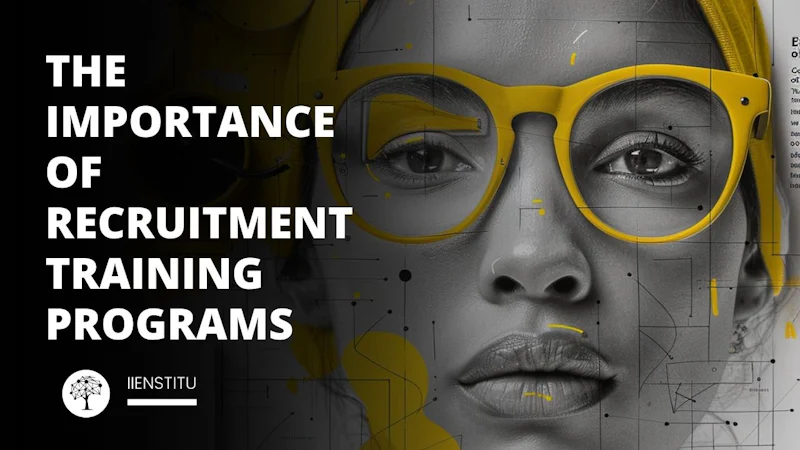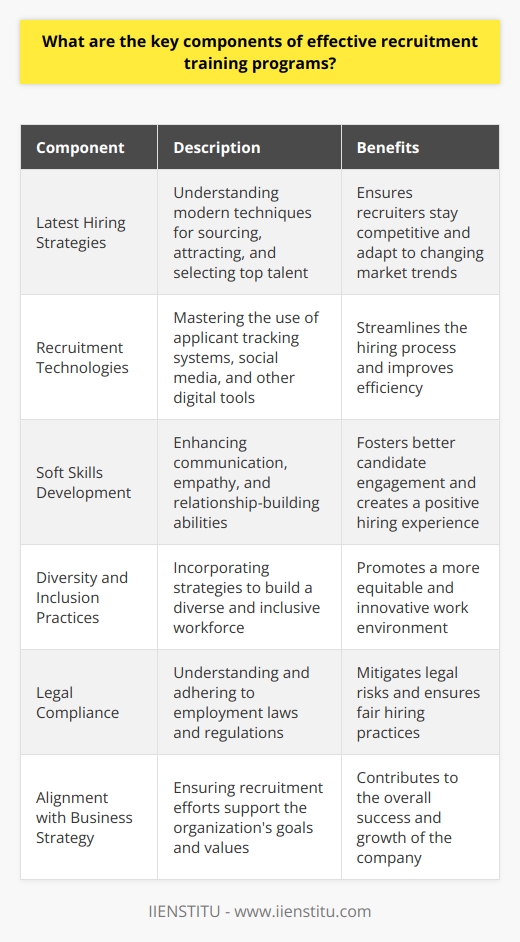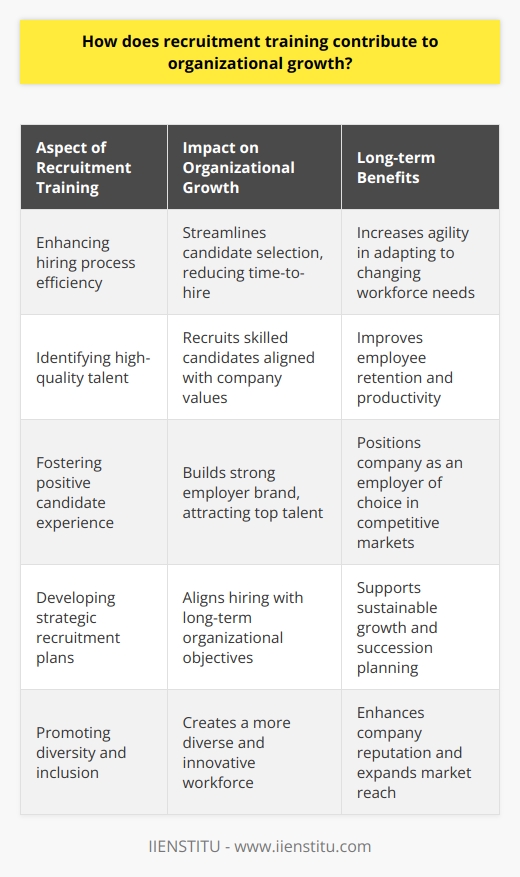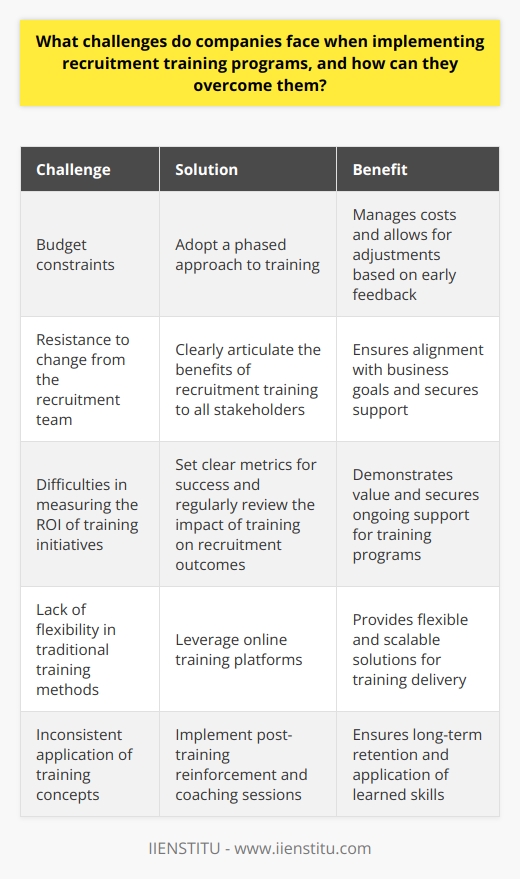In the ever-evolving landscape of the modern workplace, the importance of effective recruitment strategies cannot be overstated. With businesses vying for top talent in a competitive market, the role of HR training and talent development has catapulted from a peripheral business function to a core strategic imperative. But why exactly is recruitment training so crucial, and how does it impact the broader narrative of organizational success?
Imagine stepping into a world where every hire is not just a fill for the present but a step towards future-proofing your organization. This is the world where recruitment training programs shine, offering a beacon of light in navigating the complex maze of talent acquisition, professional development, and career growth. Through a conversational journey, this article will delve into the depths of recruitment training and development, uncovering its undeniable value in shaping the workforce of tomorrow.
From enhancing job skills to refining hiring strategies, and from streamlining the onboarding process to promoting continuous employee training, the facets of recruitment training programs are as varied as they are vital. Join me as we explore this terrain, armed with insights, analogies, and real-life examples, to uncover the explosive impact of well-orchestrated recruitment training on organizational excellence and employee fulfillment. Whether you're an HR professional seeking to elevate your recruitment game or a business leader aiming for peak performance, this exploration is tailored to ignite your understanding and passion for talent development in the modern era.
Understanding the Essence of Recruitment Training Programs
At its core, recruitment training programs represent the foundational blocks upon which companies build their talent acquisition and development strategies. But what exactly makes these programs so indispensable in today's corporate environment? Let's dive into the essence of recruitment training, exploring its components, objectives, and the transformative impact it has on both organizations and employees.
The Role of Recruitment Training in Modern Businesses
In an age where the right talent can be the difference between thriving and merely surviving, recruitment training programs stand out as a critical tool for HR professionals and recruiters. These programs are designed to equip the recruitment team with the latest techniques, tools, and insights necessary to attract, evaluate, and onboard the best candidates. But it's not just about filling positions; it's about understanding the strategic alignment between a candidate's potential and the company's vision for the future.
Components of Effective Recruitment Training

Effective recruitment training encompasses several key components:
Talent Sourcing and Attraction Strategies: Training programs often begin with the art and science of finding the right talent. This includes leveraging social media, professional networks, and employee referrals to create a robust talent pipeline.
Interviewing Skills: One of the most crucial aspects of recruitment training is developing the skills to conduct insightful, effective interviews. This not only helps in assessing the candidate's capabilities and fit but also in selling the vision of the company to prospective hires.
Onboarding Process: A smooth and engaging onboarding process is vital for new employee integration and retention. Training programs cover the best practices in onboarding, ensuring that new hires feel welcomed, valued, and prepared to contribute from day one.
Diversity and Inclusion: In today's global business environment, understanding and implementing strategies for diversity and inclusion in the recruitment process is non-negotiable. Training in this area helps recruiters navigate the complexities of building a diverse workforce that reflects the global marketplace.
Legal and Ethical Considerations: With the ever-changing legal landscape surrounding employment, training programs also cover the legalities of recruitment, ensuring that practices comply with local and international laws.
Why Recruitment Training Programs are a Game-Changer

Investing in recruitment training programs offers a multitude of benefits, from enhancing the employer brand to reducing turnover rates. Skilled recruiters are adept at identifying candidates who not only have the necessary job skills but also align with the company culture, leading to a more cohesive and productive workforce. Furthermore, effective recruitment strategies and techniques gleaned from these programs can significantly shorten the hiring cycle, saving valuable time and resources.
Moreover, in the quest for talent development, recruitment training programs lay the groundwork for ongoing professional development, signaling to employees that the company is invested in their career growth and personal development. This not only boosts morale but also fosters a culture of learning and excellence.
As we delve deeper into the nuances of recruitment training and talent development, it becomes clear that these programs are not just a nice-to-have but a must-have for organizations aiming to thrive in the competitive landscape of the 21st century. They are the engines driving the recruitment machine, ensuring that it operates with precision, efficiency, and a human touch.
Leveraging Recruitment Training for Strategic Talent Development
In the realm of recruitment and talent acquisition, training programs serve not just as a means to enhance the skills of HR professionals but as a strategic lever to propel the organization forward. This section delves into how recruitment training intertwines with talent development, creating a synergy that fuels both individual career growth and organizational success.
Bridging the Gap Between Recruitment and Talent Development
The journey of an employee within an organization is a continuum, starting from the moment they enter the recruitment funnel to their ongoing development as a key contributor. Recruitment training plays a pivotal role in this journey by ensuring that the initial steps — attracting, interviewing, and onboarding — are executed with a vision for the individual's future growth within the company. This strategic approach not only enhances the quality of hires but also lays the foundation for a robust talent development pipeline.
Integrating Professional Development into the Recruitment Process: A forward-thinking recruitment training program emphasizes the importance of professional development from the outset. By highlighting career advancement opportunities and the availability of resources for learning and growth, recruiters can attract candidates who are not just looking for a job but a place where they can evolve professionally. This alignment of recruitment strategies with professional development initiatives ensures that the organization attracts individuals who are committed to long-term growth and contribution.
The Role of Continuous Learning in Talent Retention: One of the critical challenges faced by organizations today is not just attracting top talent but retaining it. Here, the intersection of recruitment training and talent development becomes evident. Continuous learning opportunities, highlighted during the recruitment process and delivered throughout the employee's tenure, play a significant role in retention. Employees who feel that their employer is invested in their professional development are more likely to stay engaged, motivated, and loyal to the company.
Creating a Culture of Learning and Innovation: Recruitment training programs that emphasize the value of ongoing learning and skill development contribute to creating a culture of innovation within the organization. By equipping recruiters with the tools to communicate the company's commitment to professional development, organizations can attract candidates who are eager to learn, innovate, and push the boundaries of what's possible. This not only enhances the organization's competitive edge but also fosters an environment where continuous improvement is the norm.
The Strategic Advantage of Recruitment Training Programs
Ultimately, the integration of recruitment training and talent development offers a strategic advantage to organizations. It enables them to:
Attract candidates who are not just qualified but also aligned with the company's culture and long-term objectives.
Streamline the onboarding process to quickly and effectively integrate new hires into the company, setting the stage for their future success.
Foster a workplace environment that values learning, development, and innovation, making it a desirable place to work for ambitious professionals.
As organizations navigate the complexities of the modern talent landscape, the importance of a well-structured recruitment training program cannot be overstated. By focusing on the alignment between recruitment practices and talent development, companies can ensure that they not only attract the best candidates but also nurture them into the leaders of tomorrow.
The journey through the intricate world of recruitment training and development underscores its critical role in shaping the future of organizations. By investing in comprehensive training programs, companies can transform their recruitment processes into strategic assets that attract, develop, and retain top talent. In doing so, they lay the groundwork for a future where continuous learning, professional development, and organizational success go hand in hand. As we look ahead, the integration of recruitment training with talent development strategies emerges not just as a best practice, but as a fundamental pillar supporting the growth and resilience of businesses in the dynamic landscape of the 21st century.
Innovative Recruitment Techniques and Staff Training: Key to Unlocking Organizational Potential
In the competitive quest for top talent, innovative recruitment techniques and comprehensive staff training are not just advantageous; they are essential. This section explores how modern organizations can leverage these strategies to not only attract but also cultivate a workforce capable of driving significant growth and innovation.
Revolutionizing Recruitment with Cutting-Edge Techniques
The digital age has transformed the landscape of talent acquisition, necessitating a shift from traditional recruitment methods to more dynamic and innovative approaches. By adopting the latest recruitment techniques, organizations can tap into a broader talent pool and identify candidates who are not only skillful but also a perfect fit for the company culture.
Social Media Sourcing: Utilizing platforms like LinkedIn, Twitter, and Facebook allows recruiters to reach passive candidates who may not be actively searching for a new job but are open to exciting opportunities.
AI and Machine Learning: Advanced algorithms can help streamline the recruitment process, from sorting through applications to identifying the most promising candidates based on specific job requirements and cultural fit.
Employee Referral Programs: Encouraging current employees to refer candidates can significantly enhance the quality of hires, as these candidates are often a better fit for the organization's culture and values.
Empowering Staff Training for Enhanced Performance
Once the right candidates are onboard, the focus shifts to staff training, a critical component in ensuring employees not only understand their roles but are also equipped to excel in them. Effective staff training programs are designed to foster professional growth and skill development, ensuring that employees remain engaged and productive.
Onboarding Training: Comprehensive onboarding processes help new hires acclimate to the company culture and understand their responsibilities, setting them up for success from day one.
Continuous Learning Opportunities: Offering workshops, courses, and seminars on the latest industry trends and technologies ensures that the workforce stays ahead of the curve, driving innovation within the organization.
Leadership Development Programs: Identifying and nurturing potential leaders through targeted training programs can significantly impact the organization's future, preparing it to tackle new challenges and opportunities.
The Synergy of Recruitment Techniques and Staff Training
The integration of innovative recruitment techniques with effective staff training creates a powerful synergy, laying the foundation for a resilient and forward-thinking organization. This approach not only enhances the recruitment process but also ensures that once talent is acquired, it is continuously developed. The result is a workforce that is not only highly skilled and knowledgeable but also deeply committed to the organization's goals and values.
By prioritizing these strategies, companies can build a robust talent pipeline, reduce turnover rates, and foster a culture of continuous improvement and excellence. In doing so, they position themselves as employers of choice, attracting the best and brightest minds in the industry.
As we wrap up our exploration of the significance of recruitment training programs, it's clear that the integration of innovative recruitment techniques and comprehensive staff training is not just a strategy but a necessity for contemporary organizations aiming for pinnacle success. These elements are crucial in attracting, developing, and retaining a workforce that is not only proficient in their current roles but also capable of evolving with the organization's needs and aspirations.
In the rapidly changing business landscape, companies that invest in these areas will find themselves not just surviving but thriving, marked by a dynamic and innovative workforce. The future belongs to those who recognize the transformative power of recruitment and staff training, harnessing it to build an organization that is resilient, adaptable, and perpetually ahead of the curve.
Conclusion: The Transformative Power of HR Courses on Recruitment Training Programs
As we draw our discussion to a close, the pivotal role of HR courses in empowering recruitment training programs cannot be overstated. These courses are not just educational pathways but transformative journeys that equip HR professionals with the knowledge, skills, and strategies necessary to navigate the complex terrain of modern recruitment.
HR courses that focus on recruitment training programs offer a comprehensive curriculum designed to address every facet of the recruitment process. From mastering innovative recruitment techniques to implementing effective staff training methodologies, these courses prepare HR professionals to make impactful contributions to their organizations. They delve deep into the nuances of talent acquisition, providing insights into how to attract, assess, and onboard candidates who not only have the requisite skill set but also align with the company's cultural and strategic objectives.
The effectiveness of HR courses in enhancing recruitment training programs is profound. Participants emerge with a holistic understanding of the recruitment lifecycle, equipped with the tools to implement best practices that streamline the hiring process, improve candidate experience, and ultimately, contribute to the organization's success. They learn to leverage data-driven decision-making, engage in strategic talent development, and foster a culture of continuous learning and improvement.
Moreover, these courses underscore the importance of adaptability and innovation in recruitment strategies, reflecting the dynamic nature of the job market and evolving job seeker expectations. By focusing on real-world applications and case studies, HR courses ensure that learners are prepared to apply their knowledge in practical settings, driving meaningful change within their organizations.
In essence, HR courses on recruitment training programs are a catalyst for transformation. They not only enhance the competencies of HR professionals but also elevate the strategic value of the HR function itself. Organizations that invest in these courses are not just training their employees; they are future-proofing their businesses, ensuring that they remain competitive in the talent market and capable of attracting and retaining the best and brightest.
The journey through recruitment training programs, as illuminated by HR courses, is one of discovery, innovation, and growth. For those who embark on this journey, the rewards are manifold, leading to enhanced organizational performance, employee satisfaction, and ultimately, sustained success. The message is clear: investing in HR education is not merely an operational decision but a strategic imperative that shapes the future of work, one talented individual at a time.








